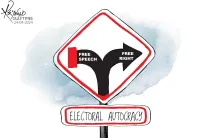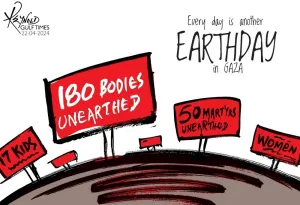Dave Duttlinger’s first thought when he saw a dense band of yellowish-brown dust smearing the sky above his Indiana farm was: I warned them this would happen.About 445 acres of his fields near Wheatfield, Indiana, are covered in solar panels and related machinery — land that in April 2019 Duttlinger leased to Dunns Bridge Solar LLC, for one of the largest solar developments in the Midwest.On that blustery spring afternoon in 2022, Duttlinger said, his phone rang with questions from frustrated neighbours: Why is dust from your farm inside my truck? Inside my house? Who should I call to clean it up?According to Duttlinger’s solar lease, reviewed by Reuters, Dunns Bridge said it would use “commercially reasonable efforts to minimise any damage to and disturbance of growing crops and crop land caused by its construction activities” outside the project site and “not remove topsoil” from the property itself. Still, sub-contractors graded Duttlinger’s fields to assist the building of roads and installation of posts and panels, he said, despite his warnings that it could make the land more vulnerable to erosion.Crews reshaped the landscape, spreading fine sand across large stretches of rich topsoil, Duttlinger said. When Reuters visited his farm last year and this spring, much of the land beneath the panels was covered in yellow-brown sand, where no plants grew.“I’ll never be able to grow anything on that field again,” the farmer said. About one-third of his approximately 1,200-acre farm — where his family grows corn, soybeans and alfalfa for cattle — has been leased.The Dunns Bridge Solar project is a subsidiary of NextEra Energy Resources LLC, the world’s largest generator of renewable energy from wind and solar. Duttlinger said when he approached NextEra about the damage to his land, the company said it would review any remedial work needed at the end of its contract in 2073, as per the terms of the agreement.NextEra declined to comment on the matter or on what future commitments it made to Duttlinger, and Reuters could not independently confirm them. Project developer Orion Renewable Energy Group LLC directed questions to NextEra.The solar industry is pushing into the US Midwest, drawn by cheaper land rents, access to electric transmission, and a wealth of federal and state incentives. The region also has what solar needs: wide-open fields.A renewable energy boom risks damaging some of America’s richest soils in key farming states like Indiana, according to a Reuters analysis of federal, state and local data; hundreds of pages of court records; and interviews with more than 100 energy and soil scientists, agricultural economists, farmers and farmland owners, and local, state and federal lawmakers.Some of Duttlinger’s farm, including parts now covered in solar panels, is on land classified by the US Department of Agriculture (USDA) as the most productive for growing crops, according to a Reuters analysis.For landowners like Duttlinger, the promise of profits is appealing. Solar leases in Indiana and surrounding states can offer $900-1,500 an acre per year in land rents, with annual rate increases, according to a Reuters review of solar leases and interviews with four solar project developers. In comparison, farmland rent in top corn and soybean producers Indiana, Illinois and Iowa averaged about $251 per acre in 2023, USDA data shows.Farmland Partners Inc, a publicly traded farmland real estate investment trust (REIT) has leased about 9,000 acres nationwide to solar firms. Much of that ground is highly productive, said Executive Chairman Paul Pittman.“Do I think it’s the best use of that land? Probably not. But our investors would kill us if we didn’t pursue this,” he said.Some renewable energy developers said not all leases become solar projects. Some are designing their sites to make it possible to grow crops between panels, while others, like Doral Renewables LLC, said they use livestock to graze around the panels as part of their land management. Developers also argue that in the Midwest, where more than one-third of the US corn crop is used for ethanol production, solar energy is key for powering future electric vehicles.Some agricultural economists and agronomists counter that taking even small amounts of the best cropland out of production for solar development and damaging valuable topsoil impacts future crop potential in the United States.Common solar farm construction practices, including clearing and grading large sections of land, also can lead to significant erosion and major runoff of sediment into waterways without proper remediation, according to the US Environmental Protection Agency and the Justice Department.Solar development comes amid increasing competition for land: In 2023, there were 76.2mn — or nearly 8% — fewer acres in farms than in 1997, USDA data shows, as farmland is converted for residential, commercial and industrial use.In response to Reuters’ findings, USDA said that urban sprawl and development are currently bigger contributors to farmland loss than solar, citing reports from the Department of Energy and agency-funded research.No-one knows how much cropland nationwide is currently under solar panels or leased for possible future development. Land deals are typically private transactions. Scientists at the United States Geological Survey and the US Department of Energy’s Lawrence Berkeley National Laboratory have been compiling a database of existing solar facilities across the country. While that project is incomplete and ongoing, Reuters found that around 0.02% of all cropland in the continental US intersected in some way with large-scale, ground-based solar panel sites they had identified as of 2021.The total power capacity of the solar operations tracked in the data set represents over 60 gigawatts of electric power capacity. In the following two years, solar capacity has nearly tripled, according to a December 2023 report from the Solar Energy Industries Association (SEIA) and Wood Mackenzie.To better understand future land-use patterns, Reuters analysed federal government data to identify cropland that USDA classified as prime, unique, or of local or statewide importance. Reuters also reviewed more than 2,000 pages of solar-related documents filed at local county recorders’ offices in a small sample of four Midwestern counties — Pulaski, Starke and Jasper counties in Indiana, and Columbia County in Wisconsin.The counties, representing an area of land slightly bigger than the state of Delaware, are where some of the nation’s largest projects are being developed or built. The sample is not necessarily representative of the broader United States but gives an idea of the potential impact of solar projects in farm-heavy counties.Reuters found the percentage of these counties’ most productive cropland secured by solar and energy companies as of end of 2022 was as follows: 12% in Pulaski, 9% in Starke, 4% in Jasper and 5% in Columbia.Jerry Hatfield, former director of USDA Agricultural Research Service’s National Laboratory for Agriculture and the Environment, said Reuters’ findings in the four counties are “concerning.”“It’s not the number of acres converting to solar,” he said. “It’s the quality of the land coming out of production, and what that means for local economies, state economies and the country’s future abilities for crop production.”More than a dozen agronomists, as well as renewable energy researchers and other experts consulted by Reuters, said the approach to measuring solar’s impact was fair. The news agency also shared its findings with six solar developers and energy firms working in these counties. Three said Reuters’ sample size was too small, and the range of findings too wide, to be a fair portrayal of industry siting and construction practices.By 2050, to meet the Biden Administration’s decarbonisation targets, the US will need up to 1,570 gigawatts of electric energy capacity from solar.While the land needed for ground-based solar development to achieve this goal won’t be even by state, it is not expected to exceed 5% of any state’s land area, except the smallest state of Rhode Island, where it could reach 6.5%, by 2050, according to the Energy Department’s Solar Futures Study, published in 2021.Researchers at American Farmland Trust, a non-profit farmland protection organisation which champions what it calls Smart Solar, forecast last year that 83% of new solar energy development in the US will be on farm and ranchland, unless current government policies changed. Nearly half would be on the nation’s best land for producing food, fibre, and other crops, they warned.Five renewable developers and solar energy firms interviewed by Reuters counter that the industry’s use of farmland is too small to impact domestic food production overall and should be balanced with the need to decarbonise the US energy market in the face of climate change. Doral Renewables, the developer behind the $1.5bn Mammoth Solar project in Pulaski and Starke counties, does not consider corn or soybean yields in its siting decisions.Instead, the company looks at the land’s topography, zoning and closeness to an electrical grid or substation — and tries to avoid wooded areas, ditches and environmentally sensitive areas, said Nick Cohen, Doral’s president and CEO.Shifting corn acres for solar? “I don’t see it as replacing something that is vital to our society,” Cohen said. Solar can make farmland “more productive from an economic perspective,” he added.Indiana farmer Norm Welker says he got a better deal leasing 60% of his farmland to Mammoth than he would have growing corn, with prices dipping to three-year lows this year.“We’ve got mounds of corn, we’re below the cost of production, and right now, if you’re renting land to grow corn — you’re losing money,” Welker said. “This way, my economic circumstances are very good.” — Reuters
Opinion
Sunday, April 28, 2024
Saturday, April 27, 2024
Friday, April 26, 2024
Sunday, April 14, 2024
Tuesday, April 09, 2024
Tuesday, April 09, 2024
Youth at rally see Trump as answer to economic woes
Thursday, April 25, 2024


























